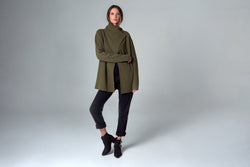We love high-quality wool knitwear; it's central to our autumn winter ranges, it's luxurious, warm, soft and sumptuous. Wool is traditionally manufactured into the products that we know and love via knitting, whether homemade or bought. But how (and where) did knitting originate? - who looked at a sheep and thought "you know what, I think that would make a lovely jumper"?
Here's how knitting originated:
Knitting dates back to 1000BC and was traditionally undertaken just using the fingers or using circular peg frames.
In fact, here's a picture of the Madonna knitting a garment for Jesus, dating back to 14th century Europe.

As Europe is a cold climate, knitting gloves, scarves and hats was (and will always be) a common practice to stay warm with handknitted, homemade items.
But, in 1589 an Englishman from Nottinghamshire named Reverend William Lee, a clergyman and inventor, built a stocking frame knitting machine that revolutionised knitting.
According to Wikipedia the Queen denied Lee a patent for his machine due to her concern of the employment of the many hand knitters whose jobs could be at risk from automation (sound familiar?!)
"Thou aimest high, Master Lee. Consider thou what the invention could do to my poor subjects. It would assuredly bring to them ruin by depriving them of employment, thus making them beggars."
So, Lee developed his machine to be used on silk, as well as wool, moved to France, set up a team there, patented his machine and began a stocking manufacturing businesses in Rouen. Lee's brother eventually brought the machines back to the UK and established 2 knitting centres and the manufacturing process and competition throughout the UK grew from there.
Thanks to Lee's machine knitting was now faster and businesses were able to thrive in knitting manufacturing. Knitting was no longer limited to stitch-by-stitch, but whole rows could be knitting at once.
"The machine was gradually refined further and by the 18th century the idea of knitting holes opened up new scope for design. By the late 19th century the knitwear industry was huge; new innovations in technology paved the way for the straight bar, flat frame." source
Thanks to modern technology and new ways of design, knitwear can be created at a lightning pace, but this also leaves some manufacturers and designers looking back to traditional styles and methods for nostalgia, a unique selling point and inspiration. This leads to exciting mixes of contemporary designs from traditional techniques.
"pushing boundaries with unusual yarns and materials and playing with scale." (source)
Browse women's knitwear online from Maxted







